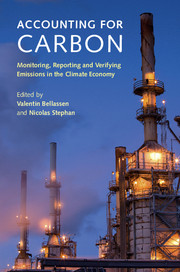Book contents
- Frontmatter
- Contents
- List of figures and map
- List of tables
- List of boxes
- Notes on contributors
- Acknowledgements
- 1 Introduction: key notions and trade-offs involved in MRVing emissions
- Part I MRV of territorial/jurisdictional emissions
- Part II MRV of industrial sites and entities
- 5 Trendsetter for companies and industrial sites: the EU Emissions Trading Scheme
- 6 Variant 1: the waste sector in Australia's Carbon Pricing Mechanism, another ETS at site level
- 7 Variant 2: non-site level emissions in an ETS–the case of electricity importers in the California cap-and-trade
- 8 Variant 3: emissions of a company/institution rather than a site: the case of the Shenzhen ETS
- 9 Variant 4: coexistence of voluntary and mandatory frameworks at the company level - Carbon Disclosure Project, EU ETS and French legal requirements
- 10 Direct measurement in the EU ETS
- Part III MRV at offset project scale
- Index
- References
5 - Trendsetter for companies and industrial sites: the EU Emissions Trading Scheme
from Part II - MRV of industrial sites and entities
Published online by Cambridge University Press: 05 March 2015
- Frontmatter
- Contents
- List of figures and map
- List of tables
- List of boxes
- Notes on contributors
- Acknowledgements
- 1 Introduction: key notions and trade-offs involved in MRVing emissions
- Part I MRV of territorial/jurisdictional emissions
- Part II MRV of industrial sites and entities
- 5 Trendsetter for companies and industrial sites: the EU Emissions Trading Scheme
- 6 Variant 1: the waste sector in Australia's Carbon Pricing Mechanism, another ETS at site level
- 7 Variant 2: non-site level emissions in an ETS–the case of electricity importers in the California cap-and-trade
- 8 Variant 3: emissions of a company/institution rather than a site: the case of the Shenzhen ETS
- 9 Variant 4: coexistence of voluntary and mandatory frameworks at the company level - Carbon Disclosure Project, EU ETS and French legal requirements
- 10 Direct measurement in the EU ETS
- Part III MRV at offset project scale
- Index
- References
Summary
Context
Lineage and birth of the EU ETS
Almost like a living organism, the European Union Emissions Trading Scheme (EU ETS) is one of the final lines of an elaborate and complex process. This process began years ago with the formal acknowledgment at international level “that change in the Earth's climate and its adverse effects are a common concern of humankind” (United Nations, 1992) and the recognition “that human activities have been substantially increasing the atmospheric concentrations of greenhouse gases, that these increases enhance the natural greenhouse effect, and that this will result on average in an additional warming of the Earth's surface and atmosphere and may adversely affect natural ecosystems and humankind” (United Nations, 1992). This recognition led to setting a goal, namely the “stabilization of greenhouse gas concentrations in the atmosphere at a level that would prevent dangerous anthropogenic interference with the climate system” (United Nations, 1992).
From this awareness and with this general objective in mind, a first operational step was taken with the highly publicized Kyoto Protocol (United Nations, 1997) which sets quantified emission reduction targets for each developed country. In order to fulfill these commitments while taking into account the technical, political and economic constraints, several tools were created including MRV procedures, flexibility mechanisms and a compliance committee.
The role of the MRV procedures is to ensure that the developed Parties to the UNFCCC monitor and submit their annual emissions in a way which assures comparability and consistency with the rules of the Protocol (see Chapter 2 on national GHG inventories under the UNFCCC). The market-based mechanisms intend to provide Parties with the possibility to abate emissions where it is cheapest. The compliance committee ultimately judges whether Parties complied with the rules and mechanisms. In particular, it solves disputes between Parties, or between a Party and an expert review team (see Chapter 2 on national GHG inventories under the UNFCCC).
- Type
- Chapter
- Information
- Accounting for CarbonMonitoring, Reporting and Verifying Emissions in the Climate Economy, pp. 139 - 189Publisher: Cambridge University PressPrint publication year: 2015
References
- 1
- Cited by



